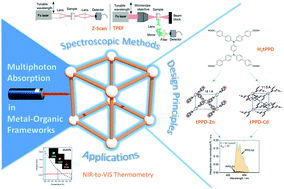Recent advances of multiphoton absorption in metal–organic frameworks†
Abstract
Inorganic–organic hybrid materials such as metal–organic frameworks (MOFs) or coordination polymers (CPs) are of high interest in chemistry and materials science due to their modular design and versatile applicability, for example in gas storage, catalysis and sensor systems. Moreover, their tunability allows for photophysically relevant applications, such as multiphoton absorption (MPA). MPA is one of the most important non-linear optical effects, employed in optical limiting and two-photon fluorescence microscopy as well as for three-dimensional data storage. In this review we outline recent advances of MOFs and CPs regarding their MPA response properties. In the first part, we discuss the theoretical background of MPA absorbing linker molecules and effect of excitonic coupling when aligned within a rigid framework assembly. Furthermore, different state-of-the-art scanning and non-scanning measurement techniques for two-photon absorption (TPA) spectroscopy are compared for their advantages as well as their limitations. Additionally, we comprehensively present the latest progress of linker-based MPA materials (MOFs or surface anchored MOFs) and the relation between their framework-structure and their MPA cross section. In the last part of this review, future applications and research directions for the above outlined materials are discussed and illustrated.



 Please wait while we load your content...
Please wait while we load your content...